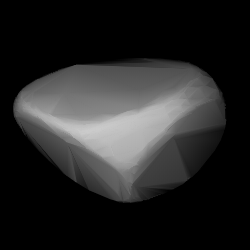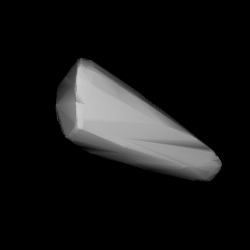Related Research Articles

1578 Kirkwood, provisional designation 1951 AT, is a Hilda asteroid from the outermost regions of the asteroid belt, approximately 52 kilometers in diameter. It was discovered on 10 January 1951, by astronomers of the Indiana Asteroid Program at Goethe Link Observatory in Indiana, United States. The asteroid was named after American astronomer Daniel Kirkwood.
1180 Rita, provisional designation 1931 GE, is a dark and spheroidal Hildian asteroid from the outermost regions of the asteroid belt, approximately 97 kilometers in diameter. It was discovered on 9 April 1931, by German astronomer Karl Reinmuth at the Heidelberg Observatory in southwest Germany. Any reference of its later name, Rita, is unknown.
1144 Oda, provisional designation 1930 BJ, is a dark Hildian asteroid from the outermost regions of the asteroid belt, approximately 57 kilometers in diameter. It was discovered on 28 January 1930, by German astronomer Karl Reinmuth at the Heidelberg-Königstuhl State Observatory. The asteroid's name is a German female name, not related to the discoverer's contemporaries.
1162 Larissa, provisional designation 1930 AC, is a metallic Hildian asteroid from the outermost regions of the asteroid belt, approximately 43 kilometers in diameter. It was discovered on 5 January 1930, by astronomer German astronomer Karl Reinmuth at Heidelberg Observatory in southwest Germany. The asteroid was named after the Greek city of Larissa.
2067 Aksnes, provisional designation 1936 DD, is a rare-type Hildian asteroid from the outermost region of the asteroid belt, approximately 44 kilometers in diameter. The asteroid was discovered on 23 February 1936, by Finnish astronomer Yrjö Väisälä at Turku Observatory in Southwest Finland. It was named after astronomer Kaare Aksnes.
2246 Bowell, provisional designation 1979 XH, is a rare-type Hildian asteroid from the outermost region of the asteroid belt, approximately 44 kilometers in diameter. It was discovered on 14 December 1979, by American astronomer Edward Bowell at Lowell Observatory's Anderson Mesa Station, and named after the discoverer himself.
2312 Duboshin, provisional designation 1976 GU2, is a dark Hildian asteroid from the outermost regions of the asteroid belt, approximately 54 kilometers (34 miles) in diameter. It was discovered on 1 April 1976, by Soviet–Russian astronomer Nikolai Chernykh at the Crimean Astrophysical Observatory in Nauchnij, on the Crimean peninsula. It was named after Russian astronomer Georgij Duboshin. The D-type asteroid has a longer than average rotation period of 50.78 hours.
1212 Francette is a dark Hildian asteroid from the outermost regions of the asteroid belt, approximately 82 kilometers in diameter. It was discovered on 3 December 1931, by French astronomer Louis Boyer at the Algiers Observatory in Algeria, North Africa, who named it after his wife Francette Boyer.

2483 Guinevere is a dark and elongated Hilda asteroid from the outermost regions of the asteroid belt, approximately 43 kilometers in diameter. The asteroid was discovered on 17 August 1928, by German astronomer Max Wolf at Heidelberg Observatory in southwest Germany and given the provisional designation 1928 QB. In the 1980s, it was named after King Arthur's wife Guinevere.
1202 Marina is a primitive Hildian background asteroid from the outermost regions of the asteroid belt, approximately 55 kilometers in diameter. It was discovered by Grigory Neujmin at the Simeiz Observatory in 1931, and later named in honor of Marina Lavrova–Berg, a scientific collaborator at Pulkovo Observatory, who died at an early age during WWII.
1748 Mauderli, provisional designation 1966 RA, is a dark and very reddish Hildian asteroid from the outermost region of the asteroid belt, approximately 45 kilometers in diameter.

1256 Normannia is a dark Hilda asteroid and slow rotator from the outermost regions of the asteroid belt, approximately 69 kilometers in diameter. It was discovered on 8 August 1932, by astronomer Karl Reinmuth at the Heidelberg-Königstuhl State Observatory in Germany. The asteroid was likely named after the Normans who gave their name to the region of Normandy in France.
1529 Oterma, provisional designation 1938 BC, is a reddish, rare-type Hildian asteroid from the outermost region of the asteroid belt, approximately 56 kilometers in diameter. It was discovered on 26 January 1938, by Finnish astronomer Yrjö Väisälä at Turku Observatory in Southwest Finland. It is named for Liisi Oterma.

1512 Oulu, provisional designation 1939 FE, is a dark Hildian asteroid, slow rotator and possibly the largest known tumbler orbiting in the outermost region of the asteroid belt. With a diameter of approximately 80 kilometers, it belongs to the fifty largest asteroids in the outer main-belt. The body was discovered on 18 March 1939, by Finnish astronomer Heikki Alikoski at Turku Observatory in Southwest Finland and named for the Finnish town Oulu.
1345 Potomac, provisional designation 1908 CG, is a dark Hildian asteroid from the outermost regions of the asteroid belt, approximately 73 kilometers (45 mi) in diameter. It was discovered on 4 February 1908, by American astronomer Joel Metcalf at the Taunton Observatory in Massachusetts, United States. The X-type asteroid has a rotation period of 11.4 hours. It was named for the Potomac River on which Washington, D.C. is located.
1269 Rollandia, provisional designation 1930 SH, is a dark Hildian asteroid from the outermost region of the asteroid belt, approximately 105 kilometers (65 mi) in diameter. It was discovered on 20 September 1930, by Soviet astronomer Grigory Neujmin at the Simeiz Observatory on the Crimean peninsula. The asteroid was named after French writer Romain Rolland. The D-type asteroid has a rotation period of 17.4 hours. It was one of the last 100-kilometer sized asteroids discovered in the main belt.
2959 Scholl, provisional designation 1983 RE2, is a carbonaceous Hildian asteroid from the outer regions of the asteroid belt, approximately 34 kilometers in diameter. It was discovered on 4 September 1983 by English–American astronomer Edward Bowell of the Lowell Observatory at Anderson Mesa Station near Flagstaff, Arizona. The asteroid was named after German astronomer Hans Scholl.

1902 Shaposhnikov is a dark Hilda asteroid from the outermost region of the asteroid belt, approximately 92 kilometers in diameter. It was discovered on 18 April 1972, by Russian astronomer Tamara Smirnova at the Crimean Astrophysical Observatory in Nauchnyj, on the Crimean peninsula. The asteroid was named after Soviet astronomer and WWII casualty Vladimir Shaposhnikov. It was one of the last larger asteroids discovered in the main belt.

4230 van den Bergh (prov. designation: 1973 ST1) is a highly elongated Hildian asteroid and member of the Schubart family from the outer regions of the asteroid belt. It was discovered on 19 September 1973, by Dutch astronomer couple Ingrid and Cornelis van Houten at Leiden Observatory, on photographic plates taken by Dutch–American astronomer Tom Gehrels at the Palomar Observatory, California. The assumed carbonaceous C-type asteroid has a very long rotation period of 88 hours and measures approximately 37 kilometers (23 miles) in diameter. It was named for Dutch–Canadian astronomer Sidney Van den Bergh.
1439 Vogtia, provisional designation 1937 TE, is a dark Hildian asteroid from the outermost region of the asteroid belt, approximately 48 kilometers in diameter. It was discovered on 11 October 1937, by German astronomer Karl Reinmuth at Heidelberg Observatory in southern Germany. It is named for astronomer Heinrich Vogt.
References
- 1 2 3 4 5 6 7 8 9 "JPL Small-Body Database Browser: 1268 Libya (1930 HJ)" (2017-06-02 last obs.). Jet Propulsion Laboratory . Retrieved 19 September 2017.
- 1 2 3 Schmadel, Lutz D. (2007). "(1268) Libya". Dictionary of Minor Planet Names. Springer Berlin Heidelberg. p. 105. doi:10.1007/978-3-540-29925-7_1269. ISBN 978-3-540-00238-3.
- 1 2 3 4 "1268 Libya (1930 HJ)". Minor Planet Center. Retrieved 19 September 2017.
- 1 2 3 4 5 "LCDB Data for (1268) Libya". Asteroid Lightcurve Database (LCDB). Retrieved 19 September 2017.
- 1 2 3 4 Usui, Fumihiko; Kuroda, Daisuke; Müller, Thomas G.; Hasegawa, Sunao; Ishiguro, Masateru; Ootsubo, Takafumi; et al. (October 2011). "Asteroid Catalog Using Akari: AKARI/IRC Mid-Infrared Asteroid Survey". Publications of the Astronomical Society of Japan. 63 (5): 1117–1138. Bibcode:2011PASJ...63.1117U. doi:10.1093/pasj/63.5.1117. (online, AcuA catalog p. 153)
- 1 2 3 4 Tedesco, E. F.; Noah, P. V.; Noah, M.; Price, S. D. (October 2004). "IRAS Minor Planet Survey V6.0". NASA Planetary Data System. 12: IRAS-A-FPA-3-RDR-IMPS-V6.0. Bibcode:2004PDSS...12.....T . Retrieved 22 October 2019.
- 1 2 3 Grav, T.; Mainzer, A. K.; Bauer, J.; Masiero, J.; Spahr, T.; McMillan, R. S.; et al. (January 2012). "WISE/NEOWISE Observations of the Hilda Population: Preliminary Results". The Astrophysical Journal. 744 (2): 15. arXiv: 1110.0283 . Bibcode:2012ApJ...744..197G. doi:10.1088/0004-637X/744/2/197. S2CID 44000310 . Retrieved 19 September 2017.
- 1 2 Dahlgren, M.; Lahulla, J. F.; Lagerkvist, C.-I.; Lagerros, J.; Mottola, S.; Erikson, A.; et al. (June 1998). "A Study of Hilda Asteroids. V. Lightcurves of 47 Hilda Asteroids". Icarus. 133 (2): 247–285. Bibcode:1998Icar..133..247D. doi:10.1006/icar.1998.5919 . Retrieved 19 September 2017.
- ↑ Behrend, Raoul. "Asteroids and comets rotation curves – (1268) Libya". Geneva Observatory . Retrieved 19 September 2017.
- ↑ Veres, Peter; Jedicke, Robert; Fitzsimmons, Alan; Denneau, Larry; Granvik, Mikael; Bolin, Bryce; et al. (November 2015). "Absolute magnitudes and slope parameters for 250,000 asteroids observed by Pan-STARRS PS1 - Preliminary results". Icarus. 261: 34–47. arXiv: 1506.00762 . Bibcode:2015Icar..261...34V. doi:10.1016/j.icarus.2015.08.007. S2CID 53493339 . Retrieved 19 September 2017.
- ↑ "Asteroid 1268 Libya – Proper Elements". AstDyS-2, Asteroids – Dynamic Site. Retrieved 29 October 2019.